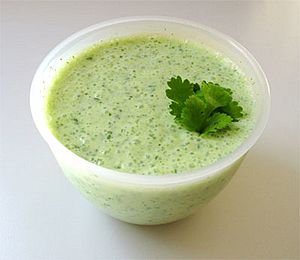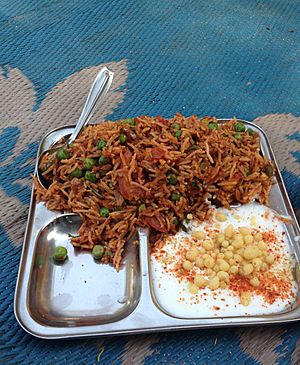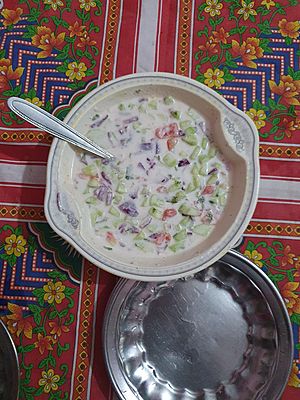Raita facts for kids

Cucumber and mint raita
|
|
| Alternative names | रायता, রায়তা Pachadi |
|---|---|
| Course | Condiment |
| Region or state | Indian subcontinent with regional variations |
| Associated national cuisine | India, Bangladesh, Pakistan, Nepal |
| Serving temperature | Cold |
| Main ingredients | Dahi (yogurt), buttermilk, cucumber, mint |
| Variations | Dahi chutney, Pachadi |
| 46 kcal (193 kJ) | |
Raita is a yummy side dish from Indian cuisine. It's made with a special kind of yogurt called dahi. People mix this yogurt with fresh or cooked vegetables, and sometimes even fruit! There's also a fun type called boondi raita, which has tiny fried drops made from chickpea flour.
Think of raita like a cool dip or a fresh salad. It's often called a condiment, but it's different from spicy sauces like mustard. Instead, raita helps cool your mouth down. This is super helpful when you're eating spicy curryes or kebabs, which are popular in many Asian countries. In India, people often eat raita with flatbreads, chutneys, and pickles.
The yogurt in raita gets its flavor from different spices and herbs. Common ones include coriander, roasted cumin seeds, mint, cayenne pepper, and chaat masala.
Contents
What's in a Name?
The word raita first appeared in books around the 1800s. It comes from the Hindi language. The name raita in Bengali language and Hindi is a mix of two older words. One is rajika (or rai), which means black mustard seed. The other is tiktaka, meaning sharp or strong.
In South India, especially in places like Kerala and Tamil Nadu, a similar traditional dish is called pachadi.
In eastern Nepal, this dish is known as dahi kakro, which means "Yogurt cucumber." In western Nepal, it's called raito. Sometimes, people just call it dahi because yogurt is the main ingredient.
How to Make Raita
To make raita, people often start by frying cumin seeds and black mustard seeds. This process is called tempering. Then, they mix these fried spices with chopped raw vegetables or fruits. Common additions include cucumber, onion, carrot, pineapple, or papaya. All of this is then mixed with the yogurt.
Sometimes, fresh ginger and garlic paste, or green chili paste, are added for extra flavor. You might even find mustard paste in some recipes.
Raita recipes can be different depending on the region in India. Some popular types are boondi raita, which has small fried balls of chickpea flour that can be salty or spicy. There are also onion raita and vegetable raita. Raita is always served chilled. It's perfect for cooling your mouth when you're enjoying spicy Indian food.
Different Kinds of Raita
Raitas can be made with three main types of ingredients: vegetables, pulses (like beans or lentils), and fruits. These are all mixed with yogurt and flavored with different seasonings to create many tasty varieties.
Vegetable Raitas
- Bathua ka raita, popular in Haryana during winter
- Cucumber raita
- Lauki (bottle gourd or calabash) raita, popular in Haryana and Uttar Pradesh
- Beetroot raita
- Brinjal raita
- Carrot raita
- Chili salt raita, made with fresh chilies or chili powder
- Horned melon raita
- Mint and peanut raita
- Onion coriander spring onion raita
- Onion tomato raita
- Potato raita
- Pumpkin raita
- Spinach raita
- Garlic mint raita
Fruit Raitas
- Banana raita
- Mango raita
- Guava raita
- Grape raita
- Pineapple raita
- Pomegranate raita
- Pear raita
Pulse Raitas
These are made from sprouted pulses, roasted pulses, or other foods made from pulse flour.
- Bhujia sev raita
- Boondi raita
- Sprouted green gram raita
How Raita is Served
As a Side Dish

Raita is usually served as a side dish to go along with main meals.
- Biryani
- Pulav (pilaf)
- Seekh kabab
- Paratha
- Pav bhaji
- Indian Thali (a plate with various dishes)
Other Uses (Not Traditional)
Sometimes, people use raita in new ways, even though it's not how it's traditionally served.
- As a sauce for grilled chicken or salmon
- As a topping for tacos
- As a dressing for salads or pasta salad
Images for kids
See also
 In Spanish: Raita para niños
In Spanish: Raita para niños








